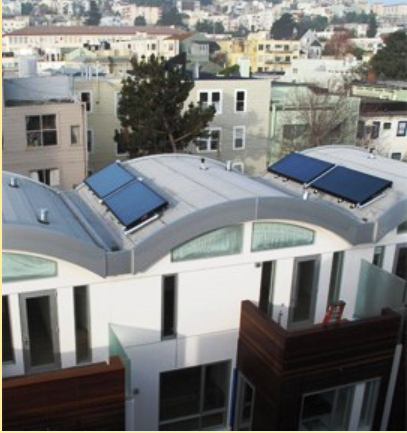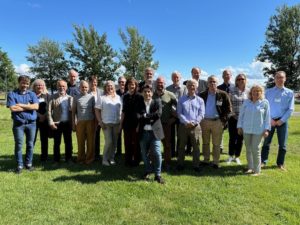
California: San Francisco Passes First Mandate with Solar Thermal Option
 After Lancaster, Sebastopol and Santa Monica, San Francisco is now the fourth – and the largest – US American city to mandate the use of solar energy in residential and commercial newbuilds. It also has the first mandate in California which can be complied with by using either solar thermal or photovoltaics. The other three cities stipulated the installation of a PV generator at newly developed premises. The mandate in San Francisco aims at owners of new residential and non-residential buildings who apply for a building permit on or after 1 January 2017. The photo shows the typical multi-storey building structure and density of San Francisco.
After Lancaster, Sebastopol and Santa Monica, San Francisco is now the fourth – and the largest – US American city to mandate the use of solar energy in residential and commercial newbuilds. It also has the first mandate in California which can be complied with by using either solar thermal or photovoltaics. The other three cities stipulated the installation of a PV generator at newly developed premises. The mandate in San Francisco aims at owners of new residential and non-residential buildings who apply for a building permit on or after 1 January 2017. The photo shows the typical multi-storey building structure and density of San Francisco. Photo: Luminalt
“Surrounded on three sides by water, San Francisco is vulnerable to the threat of climate change, so the municipality has taken proactive steps towards reducing its impact on the climate for two decades,” explained Jeanine Cotter, Owner of Luminalt Energy Corporation and member of the San Francisco Solar Task Force. Cotter has held a speech about San Francisco’s New Construction Solar Roof Mandate at the Intersolar North America this week. The city had already joined the Go 100 % Renewable Energy initiative in 2010 and passed ordinance no. 81-08 to achieve a greenhouse gas-free electric grid by 2030 and reduce emissions citywide to 40 % below 1990 levels by 2025 and 80 % by 2050.
Better Roof Requirements in effect since 1 January 2016
The new Green Building Standards Code, entitled Better Roof Requirements for Renewable Energy Facilities, was approved by the Board of Supervisors, the city council, on 19 April 2016 (see the attached document). The code requires that solar water heating systems be designed for generating 100 kBtu of thermal energy per year and square foot of allocated roof area, based on certification system OG-100 for single-family homes and OG-300 for multi-family buildings (100 kBtu/ft2 = 315 kWh/m2). Photovoltaics modules must provide at least 10 W of rated DC power per square foot of allocated roof space, based on the nameplate capacity. “Compliance is verified at building permit issuance and through the building inspection process,” Cotter confirmed.
Solar-ready requirement since July 2014
According to Cotter’s presentation, the allocated roof area had already been specified in an earlier obligation, the Solar Ready Requirement, effective since July 2014 within Title 24 of the California Code of Regulations. The regulation applies to all residential and hotel newbuilds of 10 floors or fewer and to all new non-residential buildings of three or fewer floors. The Solar Ready Requirement requires that new buildings reserve roof space for a future solar installation: 250 ft² for new single-family residences and 15 % of the roof area for multi-family and non-residential buildings. If existing structures and objects create a shaded zone on part of the building, area requirements will be reduced accordingly.
“Living roofs” could be added as eligible Green Building roof space
Cotter also explained the utility of San Francisco´s mandate for solar thermal: The majority of the city’s population lives in let flats, where hot water is typically not metered individually and where the cost for it is paid by the flat owner, who can then profit from the saving generated by the solar thermal system. Because electricity is often paid individually by the tenants and roof space is limited, a PV generator will only offset common or building loads.
“In a dense urban environment, we need to be smart and efficient about how we maximise the use of our space to achieve goals such as promoting renewable energy and improving our environment,” Supervisor Scott Wiener was quoted as saying in an April 2016 news article from The Guardian. Wiener, who introduced the green building mandate, is also involved in drafting legislation that will make “living roofs” – which provide low-cost insulation, minimise storm flooding issues and offer new wildlife habitats – to be eligible as well. The proposals are expected to be introduced over the coming weeks.
Websites of initiatives and companies mentioned in this article:


